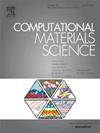用于 LPDC A357 铝合金拉伸性能预测的自适应神经模糊推理系统方法
IF 3.1
3区 材料科学
Q2 MATERIALS SCIENCE, MULTIDISCIPLINARY
引用次数: 0
摘要
本研究基于铝铸造厂希望了解在规格限制范围内合金化学性质微小变化的影响的愿望。为了确保在铸造标准的框架内铸造 A357 铝合金,并最大限度地减少铸造过程中可能出现的质量问题;本研究采用机器学习方法(ML),对合金元素之间虽然在标准范围内但由于极小变化而导致的极限拉伸强度(UTS)、屈服强度(YS)和伸长率(ε)进行了估算。实验建立了低压压铸 (LPDC) A357 Al 合金的化学成分和拉伸性能数据集。选定了 A357 合金中五个输入变量(即主要合金元素 Si 和 Mg 以及最常见的杂质含量 Fe、Ti 和 Cu)之间的关系,并通过自适应神经模糊推理系统(ANFIS)将三个输出变量(即 UTS、YS 和 ε)联系起来。ANFIS 模型预测,影响拉伸性能的最不利因素是铁含量。根据该模型,合金中铁含量之后对 UTS、YS 和 ε 的相对重要性顺序分别为 Si、Mg 和 Ti 含量。本文章由计算机程序翻译,如有差异,请以英文原文为准。
Adaptive neuro-fuzzy inference system approach for tensile properties prediction of LPDC A357 aluminum alloy
This study is based on the desire of aluminum casting foundries to understand the influence of minor changes, within the specification limits, in the alloy chemistry. In order to ensure the casting of A357 Al alloys within the framework of the casting standards and to minimize the quality problems that may arise during casting; the estimation of ultimate tensile strength (UTS), yield strength (YS) and elongation (ε) due to very small changes among the alloying elements, although they are in the standard range, by using machine learning method (ML), were studied. The dataset of chemical composition and tensile properties of Low-Pressure Die Cast (LPDC) A357 Al alloy were experimentally established. The relationship between five input variables in the A357 alloy, namely the main alloying elements Si and Mg together with the most common impurity contents Fe, Ti and Cu were selected and three outputs (i.e UTS, YS and ε) were linked by Adaptive Neuro Fuzzy Inference System (ANFIS). The ANFIS model predicted that the most detrimental element affecting tensile properties was Fe content. According to this model, the order of the relative importance on UTS, YS and ε revealed as Si, Mg and Ti content respectively after the Fe content of the alloy.
求助全文
通过发布文献求助,成功后即可免费获取论文全文。
去求助
来源期刊

Computational Materials Science
工程技术-材料科学:综合
CiteScore
6.50
自引率
6.10%
发文量
665
审稿时长
26 days
期刊介绍:
The goal of Computational Materials Science is to report on results that provide new or unique insights into, or significantly expand our understanding of, the properties of materials or phenomena associated with their design, synthesis, processing, characterization, and utilization. To be relevant to the journal, the results should be applied or applicable to specific material systems that are discussed within the submission.
 求助内容:
求助内容: 应助结果提醒方式:
应助结果提醒方式:


